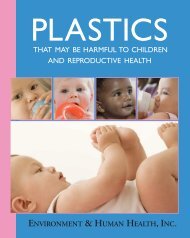LEED Report - Environment & Human Health, Inc.
LEED Report - Environment & Human Health, Inc.
LEED Report - Environment & Human Health, Inc.
- No tags were found...
Create successful ePaper yourself
Turn your PDF publications into a flip-book with our unique Google optimized e-Paper software.
The Green Building DebateSource: The table was developed using EPA’s indoor air quality website and CDC websites, NHANES 1999–2000,2001–2002 and 2003–2004. Available: http://www.cdc.gov/exposurereport (See Notes, page 72).NHANES FindingsPopulation Subgroups At RiskN/AN/ASeven forms of arsenic were examined by thestudy; DMA (metabolite of ingested inorganicarsenic) and arsenobetaine (ingested organic formof arsenic found in seafood) were the majorcontributors.Urinary arsenic levels greatest in Mexican-Americanmales; among non-Hispanic participants, females hadhigher levels of total urinary arsenic than males; forboth total urinary arsenic and total DMA levels, the12- to 19-year-old age group had lower levels thaneither the 6- to 11-year-old age group or the 20 yearsand older age group.BPA is found in the urine of nearly 93% of thepeople tested (age 6 years and older).Females had significantly higher levels of BPA in theirurine than males; children had the highest levels,followed by teens and adults; non-Hispanic blacksand non-Hispanic whites had higher levels of BPAthan Mexican Americans; people with the lowesthousehold incomes had higher levels than people inthe highest income bracket.Among the polybrominated diphenyl ethers(PBDEs), BDE-47 was detected in almost all of thepeople in the study, and at higher levels than theother PBDEs measured; BDE-28, BDE-99, BDE-100and BDE-153 were detected in more than60% of the population.BDE-28, BDE-99, BDE-100, BDE-153 and BDE-47decreased with increasing age. Levels of BB-153 (thediscontinued polybrominated biphenyl, PBB) increasedwith age, either due to the longer time that BB-153stays in the body or to past exposures that were greateramong older people; Mexican Americans and thoseborn in other countries had lower levels of BB-153.N/AEPA is investigating the potential health risks offormaldehyde emissions from pressed wood products. 761







